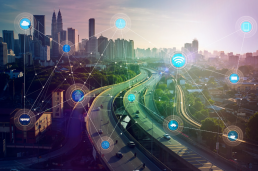Sustainability Headwinds - An Opportunity for Europe
Sustainability advocates are assessing changes that the new administration of President-elect Trump, due to take office in January, may make in U.S. environmental policies. Concerns include potential withdrawal of the United States from the Paris Climate Accords, cuts to investments in renewable energy, and changes in enforcement of climate-related reporting at the federal level.
The sustainability outlook is further clouded by limited outcomes at COP29. The UN Climate Change Conference was held in November in Azerbaijan, the third petrostate in a row to host the annual event (following the UAE in 2023 and Egypt in 2022).
All is not lost, however: This state of affairs offers an opportunity for Europe to strengthen and expand its role as a sustainability leader. The EU should seize this moment to reinforce its commitment to sustainability and spark a global renewal of the climate agenda.
The need for climate action is growing more urgent by the day. Scientists at the Copernicus Climate Change Service have predicted that 2024 will be the hottest year on record and the first calendar year in which global temperatures will have warmed 1.5C above pre-industrial times. Scientists warn that, after this threshold is crossed, Earth may reach the tipping point at which the catastrophic effects of global warming cannot be averted.
The European Green Deal
The ambitious goals of the EU’s Green Deal aim to make Europe the first climate-neutral continent by 2050. The EU now has a chance to double down on these efforts and lead by example. By investing in renewable energy, promoting sustainable manufacturing and agriculture, and driving social sustainability initiatives, Europe can not only reduce its carbon footprint but also create a robust, future-ready, and sustainable economy.
Such leadership can inspire other regions to follow suit, fostering global collaboration in the fight against climate change, wider environmental damage, and the deepening societal divide.
Europe’s diverse landscape allows for a variety of innovative approaches to sustainability. From Germany’s Energiewende (energy transition) to Portugal’s solar energy projects, Finland’s circular economy strategy, and Denmark’s wind energy initiatives, there’s a wealth of knowledge and experience that can be shared and expanded upon. Businesses — in collaboration with each other and innovative start-ups — must lead the way, while politicians should continue to build investment security via concise and reliable regulatory frameworks.
Digital Technologies for Sustainability
A crucial element in achieving sustainability leadership is the deployment of digital technologies, including:
• IoT and AI to optimize energy use, reduce waste, and improve the efficiency of supply chains
• Digital platforms and automation to facilitate greater transparency in environmental reporting and compliance, ensuring that sustainable practices are maintained and improved
• Geospatial intelligence combined with AI to enable climate adaptation and help to manage climate risk
• Digital twins supporting R&D and innovation processes to develop new, sustainable business models as well as approaches to enable reverse logistics, remanufacturing, and recycling of products and materials
By embracing these technologies and driving innovation initiatives, Europe can enhance its sustainability performance as well as serve as a beacon for other regions looking to adopt similar practices.
Tech vendors have an opportunity to support these developments and benefit in the medium and long term. We predict spending on ESG sustainability tech products/services in EMEA to grow by 19% on average over the next five years, reaching $104 billion in 2027.
To gain a share of this market, tech vendors should innovate responsibly and sustainably, keeping in mind the impact of technology itself (e.g., the energy consumption of AI use) as well as the impact of technology use cases (e.g., downstream Scope 3 emissions resulting from the use phase of products or services).
In conclusion, the results of the U.S. elections present a unique opportunity for Europe to strengthen and solidify its role as a global sustainability leader. By continuing to innovate and invest in sustainability technologies, Europe can pave the way for a more sustainable future for all — while at the same time establishing the conditions for future growth. The current headwinds can be transformed into future tailwinds for European business and economy.
For more information on the tech vendor opportunities, watch our latest webcast: Sustainability Headwinds: Re-Energizing Your Momentum for the Sustainability Tech Opportunity.
Developing the CIO Agenda in Europe for 2025 and Beyond
We have just released our latest report, highlighting 10 critical predictions for CIOs worldwide. As we look toward 2025, the pivotal role of technology in driving business success in Europe has never been more apparent.
In a new era of rapid technology-driven transformation, CIOs must be at the forefront, managing new cybersecurity threats while navigating the fundamental uniqueness of AI innovation and the complexities of evolving regulations.
The Unprecedented Imperative
As European organizations head into an uncertain future, they are facing unprecedented challenges and opportunities. The rapid evolution of AI technologies, coupled with increasingly stringent regulatory requirements and political uncertainty, is reshaping the landscape in which businesses operate. With data privacy laws expanding, particularly in Europe, and the growing demand for responsible AI, CIOs are being called upon to not only drive business advantage but also to ensure that innovation aligns with ethical standards and compliance frameworks.
These shifts require CIOs to adopt a more strategic role, balancing the pursuit of organization-wide innovation with the need to manage risk and maintain regulatory compliance. According to our research, by 2025, over 85% of organizations will formalize AI governance policies to align with business goals, a clear indication that the governance of emerging technologies is a top priority.
Increasing Responsibility Demands a Different Approach
Looking ahead, the role of the CIO is expected to expand even further. The increasing threat landscape is driving organizations to diversify their cybersecurity strategies, with 55% of CIOs expected to broaden security measures by 2026 to protect against new and evolving threats and attackers. Additionally, by 2027, we predict that 65% of CIOs will be directly responsible for integrating sustainability goals into technology projects, reflecting the growing importance of environmental, social, and governance (ESG) considerations.
These predictions highlight the need for CIOs to stay agile and proactive. The focus is not only on driving business success through technological innovation, but also on aligning these initiatives with longer-term strategic objectives, such as eliminating legacy infrastructure, introducing new skills, and developing the workforce to harness newly available opportunities. The ability to navigate this complex environment will differentiate successful organizations from those that struggle to keep pace.
Opportunities for CIOs in 2025
The future presents a few opportunities for CIOs to drive strategic changes within their organizations:
• Stay Abreast of the Evolving Regulatory Landscape: For multinational enterprises, navigating the patchwork of regulations across Europe and beyond is increasingly complex. By 2025, half of the G1000 will struggle with divergent regulatory changes that could hinder AI innovation. These changes require CIOs to adopt robust compliance strategies, ensuring that their technology deployments are aligned with both local and international standards.
• Technical Debt Reduction: By 2025, 40% of CIOs will prioritize initiatives to reduce technical debt, leveraging modernization efforts to gain a competitive edge. This shift will enable faster time-to-market and greater operational efficiency.
• Moving Beyond AI Experimentation: This means shifting from pilot projects to implementation, where AI drives tangible business outcomes. By focusing on the ROI of AI investments, CIOs can guide the organization towards unlocking real value, streamlining operations, and gaining competitive advantage. The key will be to transition from isolated tests to integrated AI strategies and platforms across and with ecosystem owners.
• AI and Cyber Resilience: As AI becomes integral to incident management, organizations that effectively integrate AI-infused applications will significantly improve their resilience. By 2027, only half of organizations will fully leverage AI for proactive incident detection, highlighting a significant area for CIOs to focus on.
• Strategic Workforce Development: With 80% of G1000 CIOs expected to be hired from outside their current organizations by 2028, there is a clear trend toward bringing in fresh perspectives and skills to lead digital transformation. This represents opportunities for CIOs who can demonstrate increased business value and risk reduction early. Across Europe, upskilling and reskilling current teams will be crucial to maintain competitiveness.
• Shift Sustainability from Corporate Buzzword to a Strategic Imperative: By embedding sustainability goals into technology projects, CIOs can drive both cost efficiencies and stimulate brand loyalty across Europe. The push toward ESG integration is not only about compliance reporting but also about future-proofing organizations against environmental and societal risks.
The 10 Predictions for 2025
1. Regulatory Complexity: By 2025, 50% of the G1000 will face challenges adapting to divergent regulatory changes, impacting their AI strategies.
2. AI Governance: By 2025, 85% of organizations will formalize AI risk management policies to align with business goals.
3. Technical Debt: By 2025, 40% of CIOs will focus on reducing technical debt for competitive advantage.
4. AI Experimentation: By 2026, over one-third of organizations will need to move beyond experimental AI projects to realize ROI.
5. Responsible AI: 80% of CIOs will establish roadmaps for responsible AI by 2026.
6. Cybersecurity Expansion: 55% of CIOs will diversify security strategies by 2026 to address new threats.
7. Sustainability Goals: By 2027, 65% of CIOs will embed sustainability into technology projects.
8. AI-Infused Incident Management: By 2027, only 50% of organizations will fully leverage AI for incident management.
9. CIO Hiring Trends: 80% of G1000 CIOs will be hired externally by 2028, emphasizing the need for digital innovation and strategic leadership skills.
10. Bridging the Skills Gap: By 2028, 50% of G1000 will adopt tools to address digital and AI skills shortages.
Recommendations for CIOs
To successfully navigate these trends and drive organizational success, CIOs should consider the following strategies:
• Invest in AI and Automation: Focus on scalable AI solutions that deliver clear ROI and enhance operational resilience.
• Prioritize Technical Debt Remediation: Embed debt reduction into digital roadmaps to accelerate innovation and efficiency.
• Develop a Strong Compliance Framework: Align technology initiatives with global regulations, particularly around AI governance and data privacy.
• Embrace Sustainability: Integrate ESG goals into all technology projects to enhance both environmental impact and operational efficiencies.
• Focus on Workforce Development: Upskill existing talent and leverage low-code platforms to close the digital skills gap.
• Strengthen Cybersecurity: Diversify security strategies to protect against evolving threats, ensuring both resilience and compliance.
As we move into 2025 and beyond, the role of the CIO is more critical than ever. By aligning technology initiatives with strategic business objectives and embracing a proactive approach to regulatory compliance, sustainability, and workforce development, CIOs can position their organizations for sustained growth and success in a rapidly changing digital landscape.
The Ellinikon: A Smart and Sustainable District Project Led by Lamda Development
As part of our Smart Cities research, we have been documenting the expanding role of architecture, engineering, and construction (AEC) firms, commercial real estate (CRE) companies, and developers as key orchestrators of these initiatives.
The Ellinikon project in Greece provides a compelling example of this burgeoning ecosystem. The Ellinikon is set to become Europe’s largest urban redevelopment initiative, transforming the Athens’ former international airport into a green Smart City district on the Athens Riviera.
The project is not spearheaded by the municipal government but by Lamda Development. Although the government has provided coordination for this megaproject, it has not provided any financial backing.
Covering over six million square meters, the multibillion-euro project aims to set new global standards for Smart Cities.
We sat down with Manthos Papamatthaiou, Lamda Development’s business development director for Smart City and ICT, Dimos Panagiotis, business development senior manager, and Paraskevi Panagopoulou, business development associate, to learn more about the project and the organization’s Smart City expertise.
[The responses below are some of the highlights of the interview. The full interview is available here for subscribers to Worldwide Smart Sustainable Cities, States, and Spaces: AI, Cloud, and Edge Strategies.]
What is your vision for The Ellinikon project?
Our overarching goal, as outlined in The Smart Ellinikon Vision, is to create “a state of-the-art smart district that pioneers the future of home, work, and entertainment; utilizing technology to deliver sustainability and serve the people of tomorrow.” We are following an integrated approach where solutions merge seamlessly into daily life without causing disruption. These solutions are designed to be outcome-focused rather than technology-driven, ensuring that each bit of technology either adds value and enhances the experience of residents, tourists, and employees or serves our sustainability and environmental protection targets. As part of this initiative, we have already completed the technology master plan and are entering the build phase of digital infrastructure and smart use cases across various domains such as smart infrastructure, mobility, energy, and waste management.
At the heart of our project lies sustainability, guided by The Ellinikon Sustainable Development Strategy and Lamda Development’s ESG goals and commitments. This approach aligns with the expectations of future residents and visitors as well as EU regulations.
Which cities are you looking to for examples of best practice?
We’ve thoroughly studied all major Smart City initiatives worldwide, focusing on both the success stories and lessons learned. The 15-minute city idea from Paris, for instance, significantly influenced the masterplan developed by Foster + Partners. The location suits perfectly the “city within a city” concept, with the mountains behind, the sea in front, and excellent connectivity to downtown Athens. One takeaway from other Smart City projects is the importance of having the right internal skills to ensure seamless operations.
How did you build the business case and determine the ROI of integrating smart technologies into the urban redevelopment project?
To establish the business case, we cooperated with international consultants like Deloitte and AFRY and conducted a feasibility study to define the sizing, costing, and benefit of each solution. We leveraged a large pool of relevant data from comparable projects to shape a solid set of assumptions. The feasibility study successfully quantified both the direct and indirect benefits of building a Smart City. The indirect value was reflected as a tangible premium in the real estate value prices, attributed to the appeal of having a residence or a business located within a smart district. This value of living in one of the leading smart districts in Europe ends up with a very interesting figure that significantly supported our decision-making processes.
When did Lamda Development establish its Smart City team?
The department was established over three years ago, at the urban planning phase and prior to any construction works. We started by defining the principles and vision for Smart Ellinikon, and then moved on to the identification of opportunities. What began as just a high-level concept has now evolved into an ambitious, approved, large-scale project. We are currently refining the design and initiating the implementation of the city’s “digital layer.” Given the breadth of available solutions and the potential for value creation, it’s clear that investing in dedicated Smart City teams early on is a wise move for all large-scale developers.
The Ellinkion’s Smart City team is ambitious. The project represents both a major advance in urban planning and a testing ground for the latest innovations in Smart City technologies. By incorporating digital technologies across every layer of the development — from energy management and transportation to waste management — the initiative aims to set new global standards for Smart Cities.
As demonstrated by Lamda Development, the role of developers, AEC firms, and CRE companies is shifting within the urban innovation ecosystem. IDC has found that 40% of AEC and 50% of CRE companies have established dedicated technology and innovation departments — numbers that are set to increase significantly over the next two years. These organizations are also increasingly partnering with technology companies in arrangements such as preferred partners in support of urban innovation initiatives.
As exemplified by Papamatthaiou and his team, building in-house Smart City expertise is becoming more common among developers. These organizations should be seen as key players in the Smart City ecosystem.
We expect these companies to have a noticeably large presence at this November’s Barcelona Smart City Expo, which we will attend.
Further reading: IDC Government Insights: Worldwide Smart Sustainable Cities, States and Spaces: AI, Cloud and Edge Strategies
The Great AI Race or Does Meticulous Preparation Trump Hasty Implementation
AI is the latest focus of the corporate world’s pursuit of innovation. Executives are understandably eager to harness AI’s potential for efficiency, cost-cutting, and a competitive edge. But here’s a radical notion: Perhaps we shouldn’t approach AI projects with the haste of a start-up chasing its first unicorn valuation.
The “move fast and break things” ethos, once Silicon Valley’s battle cry, is about as appropriate for AI implementation as using a sledgehammer for neurosurgery. You might make an impact, but the collateral damage could be catastrophic.
Let’s be clear: AI isn’t just another IT project you can cobble together with clever coding and optimistic projections. It’s a sophisticated, data-dependent set of technologies that demands respect, thorough preparation, and patience. However, while meticulous preparation is essential, it should not paralyze organizations from embarking on their AI journey. Finding a balance is key.
The Data Foundation: Quality Over Quantity
Imagine your company has invested heavily in AI technology, assembled a crack team of data scientists, and your board is salivating for results. There’s just one snag — your data is a mess. It’s like building a Formula One car and fueling it with crude oil.
AI’s effectiveness is directly proportional to the quality of data used in its implementation If your company’s information is fragmented across incompatible systems, riddled with errors, and as organized as a toddler’s playroom, your AI project is doomed from the start.
Building a robust data foundation isn’t glamorous. It doesn’t generate exciting headlines or impressive slides. But it’s the bedrock of successful AI initiatives. This means time and resources must be dedicated to data cleaning, integration, and governance. It means creating a unified, reliable data source for your AI. This preparatory work may delay your AI launch, but it ultimately delivers value across your entire organization.
Still, organizations shouldn’t wait indefinitely before launching AI initiatives. Many successful companies have begun with targeted use cases while simultaneously improving their data quality. This dual approach allows them to learn and adapt as they go.
Knowledge: The Critical Superpower
Ask yourself: Does your organization truly understand AI? We’re not talking about buzzword-laden superficiality. I mean a deep, nuanced comprehension of AI’s capabilities, limitations, and pitfalls. Without this understanding, you’re navigating treacherous waters blindfolded.
Building AI literacy isn’t just about sending your tech team to conferences; it involves fostering company-wide understanding. Educate everyone from the C-suite to frontline staff on AI’s real-world applications and limitations. Tackle ethical implications head-on and establish robust governance.
It also involves ensuring compliance with regulations such as Article 4 of the EU’s AI Act. This article states that providers and deployers of AI systems shall take measures to ensure a sufficient level of AI literacy of their staff. This highlights the importance of tailoring education to the technical knowledge and experience of staff involved in operating these systems.
This educational journey takes time and resources, but it shouldn’t deter organizations from initiating AI projects. A phased approach enables companies to build knowledge while actively engaging in practical applications of AI.
Preparing Your Workforce: Beyond Technical Skills
Here’s where many companies falter: They focus solely on technical AI skills, neglecting the broader organizational and cultural shifts necessary for successful AI adoption.
Effective AI integration requires more than just data scientists and machine learning engineers. It demands a workforce that can collaborate with AI systems, interpret their outputs, and make informed decisions based on AI-generated insights.
This means cultivating a range of “AI-adjacent” skills:
- Critical Thinking: Employees must be able to question AI outputs and understand their limitations.
- Data Literacy: A basic understanding of data analysis and statistics is crucial across roles.
- Ethical Reasoning: Staff need to recognize and address potential biases or ethical issues in AI systems.
- Adaptability: As AI reshapes job roles, employees must be willing to evolve and learn continuously.
Truly strategic AI implementation may require organizational restructuring. Traditional hierarchies may need to flatten, allowing for more rapid decision-making based on AI insights. Cross-functional teams become essential, breaking down silos between IT, data science, and business units.
Cultural shifts are equally critical. Foster a culture of experimentation and learning from failure — this is essential when working with evolving technologies. Encourage transparency about AI’s capabilities and limitations to build trust. Address fears of job displacement directly, emphasizing AI as a tool to augment human capabilities, not replace them.
Importantly, these changes can’t be afterthoughts; they should be integral to your AI strategy from day one. Involve HR, change management specialists, and department heads in planning.
In a World of Tortoises and Hares, Be a…
Imagine two companies: The hare races to implement AI everywhere without proper preparation. The tortoise methodically builds its data foundation, educates its workforce, and carefully plans its strategy.
Initially, the hare makes headlines with rapid implementations. However, over time it grapples with inconsistent results due to poor foundational work. Meanwhile, the tortoise rolls out its first meticulously planned project after thorough preparation.
Fast forward a few years. The hare has scaled back its ambitions due to high-profile failures. But the tortoise enjoys consistent improvements in efficiency driven by well-implemented solutions.
What if neither the tortoise nor the hare resonates with your organization?
Enter the bat — a creature that thrives in darkness and is adept at navigating complex environments using echolocation.
Just as bats use their acute senses to adapt quickly and effectively to their surroundings, organizations should embrace a flexible approach to AI implementation. This means being agile enough to pivot based on real-time feedback while ensuring a solid foundation is in place. Bats can fly swiftly when needed — but they also take time to explore and understand their environment.
The moral? In AI, being Batman, aka Bruce Wayne, is often the winning strategy.
The Virtue of Thoughtful Progress
In a business world obsessed with speed, advocating for patience might seem naïve. But with AI, it’s essential for long-term success.
Effective AI implementation often isn’t about being first. It’s about building the strongest foundation while understanding technology deeply and integrating it effectively into business processes and culture. It’s about creating sustainable solutions that deliver real value — not just flashy demos.
To companies feeling pressured to jump into AI: Resist the urge to rush blindly forward or become paralyzed by over-preparation. Focus on getting your data right while simultaneously exploring use cases that allow you to learn iteratively. Plan carefully; execute methodically; prepare for a marathon, not a sprint.
The winners in this race won’t be those who move fastest but those who skillfully navigate between thoughtful preparation and timely execution.











